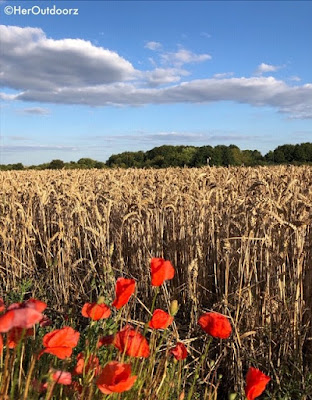A Seasonal Celebration of the Land, Garden & Nature

Harvest, Dahlias, Abundance, Summer Holidays, Corn dollies, Ripening, Sunflowers, Bare feet, Barbecues, Wheeling Swifts, Fruit & Berries, Summer Waning, Chillier Evenings
Issue 24 August 2020
Lammas
& the month of August
Tomorrow sees the start of the brand new month of August. The month of summer holidays, long languid days of fun spent outside, images of the English seaside and no school! Or at least that's how I remember it from my childhood.
"Fairest of months ripe Summer's Queen
The hey-day of the year
With robes that gleam with sunny shean,
Sweet August doth appear."
- R. Combe Miller
There's a joie de vivre to August. The garden's full of bright colours, the fields ripen to gold, hedgerows fill with ripening berries, there's an abundance of produce and fruit and as Burns put it ' and every happy creature'!
Certainly there's a suspension of activity in August. The mad roller coaster of life halts at the top. Poised. Things slow. There's a feeling of getting outside and enjoying this full month of summer. The feeling intensified by the knowledge that summer is waning and Autumn is just around the corner. The signs already showing - the touch of damp in the early morning, a golden tone in the light and that distinctive early Autumn smell.
This year in particular there's an even stronger sense of getting outside and embracing the summer. We've worked hard, struggled and adapted. So for now let's enjoy the turning of the year, the fullness, the ripening, the warm bodies and the sunny fun of August.
ROOTS
Although
August is now the eighth month of year, in the ancient Roman calendar it was
the sixth and originally called Sexilis.
The month was bestowed its current name around 8BC, to honour Emperor Augustus,
not for his birth month but because he won many of his greatest victories in
August. At the same time the month was given 31 days to match July, named after
Julius Caesar - so as not to show any favouritism!
LAMMAS
Lammas is the first of
the harvest festivals in the Celtic calendar that marks key points in the
agricultural year. This festival falls on 1
August, marking the wheat harvest and the arrival of the first
berries. The Anglo Saxons referred to it as the 'feast
of the first fruits'.
It
was a time of hard work, harvesting and bringing in the crop by day then
enjoying the bread and beer by night! The grain was collected and this became
the seed for the following years crops.
The
name Lammas derives from 'Loaf mass' and
at Lammastide a loaf of bread baked from the newly harvested crop was taken
into church to be blessed.
The
festival's also referred to as Lughnasadh,
named for Lugh the ancient
Irish god of agriculture and harvest. There are many legends of Lugh
fighting evil and it is said that he created the festival of Lughnasadh to
honour his mother who worked tirelessly clearing the lands of Ireland, so
agriculture could succeed. The gaelic names for August still refer to this
ancient festival -
The
harvest festivals were a time for giving thanks for the fruitfulness of the
land. An appreciation of the bounty collected to nourish bodies through the
coming winter and importantly a time of fun after all the hard work. It
acknowledged the turning of the year, the seasonal point when growth stopped
and ripening took over and the start of early preparations for winter.
Although
our lives are now generally less connected to the land, the cycle remains the
same and the year still turns. I think some of these ancient rituals still have a place in today's modern world. You could mark .
However you decide to spend Lammas do try and get outside this month and appreciate the turning of the year. I'll be back with more August highlights next week but in the meantime I'd love to hear what you spot and/or photograph.
If you have any questions you can reach me via my website www.plotgardendesign.co.uk follow/like PLOT Garden Design on social media to receive my seasonal updates and photos.
Keep well, breathe and remember to look outside and notice the details.




Comments
Post a Comment